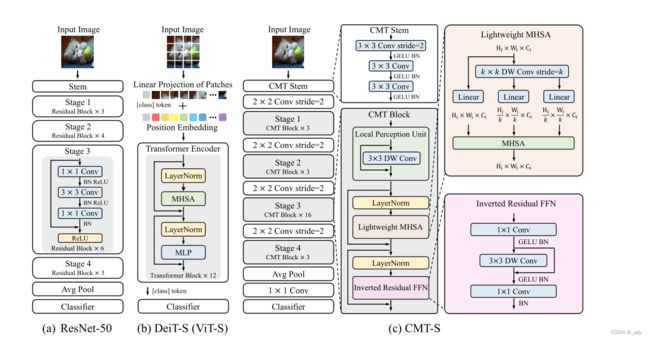CMT
- 概要
- 介绍
-
- transformer存在的问题
- CMT中块的设计
- 相关工作
-
- 方法
-
- 代码解析
-
概要
CNN捕获局部信息,Transformer来捕获全局信息
介绍
transformer存在的问题
- 将图片打成patch,会忽略图片内部潜在的2D结构和空间局部信息。
- transformer的块输出和输入大小固定,难以显示提取多尺度特征和低分辨率的特征。
- 计算复杂度太高。自注意力的计算与输入图片的大小成二次复杂度。
CMT中块的设计
- CMT块中的局部感知单元(LPU)和反向残差前馈网络(IRFFN)可以帮助捕获中间特征内的局部和全局结构信息,并提高网络的表示能力。
相关工作
CNN
| 网络 |
特点 |
| LeNet |
手写数字识别 |
| AlexNet & VGGNet & GoogleNet & InceptionNet |
ImageNet大赛 |
| ResNet |
泛化性增强 |
| SENet |
自适应地重新校准通道特征响应 |
Vision Transformer
| 网络 |
特点 |
| ViT |
将NLP中的Transformer引入到CV领域 |
| DeiT |
蒸馏的方式,使用teacher model来指导Vision Transformer的训练 |
| T2T-ViT |
递归的将相邻的tokens聚合成为一个,transformer对visual tokens进行建模 |
| TNT |
outer block建模patch embedding 之间的关系,inner block建模pixel embedding之间的关系 |
| PVT |
将金字塔结构引入到 ViT 中,可以为各种像素级密集预测任务生成多尺度特征图。 |
| CPVT和CvT |
cnn引入到transformer之中 |
方法
整体架构
- CMT stem(减小图片大小,提取本地信息)
- Conv Stride(用来减少feature map,增大channel)
- CMT block(捕获全局和局部关系)

CMT Block
LPU
- 位置编码会破坏卷积中的平移不变性,忽略了patch之间的局部信息和patch内部的结构信息。
- LPU来缓解这个问题。
LMHSA
- 使用深度卷积来减少KV的大小,加入相对位置偏置,构成了轻量级的自注意力计算。
IRFFN
- 深度卷积增强局部信息的提取,残差结构来促进梯度的传播能力。
代码解析
LPU
class LocalPerceptionUint(nn.Module):
def __init__(self, dim, act=False):
super(LocalPerceptionUint, self).__init__()
self.act = act
self.conv_3x3_dw = ConvDW3x3(dim)
if self.act:
self.actation = nn.Sequential(
nn.GELU(),
nn.BatchNorm2d(dim)
)
def forward(self, x):
if self.act:
out = self.actation(self.conv_3x3_dw(x))
return out
else:
out = self.conv_3x3_dw(x)
return out
IRFFN
class InvertedResidualFeedForward(nn.Module):
def __init__(self, dim, dim_ratio=4.):
super(InvertedResidualFeedForward, self).__init__()
output_dim = int(dim_ratio * dim)
self.conv1x1_gelu_bn = ConvGeluBN(
in_channel=dim,
out_channel=output_dim,
kernel_size=1,
stride_size=1,
padding=0
)
self.conv3x3_dw = ConvDW3x3(dim=output_dim)
self.act = nn.Sequential(
nn.GELU(),
nn.BatchNorm2d(output_dim)
)
self.conv1x1_pw = nn.Sequential(
nn.Conv2d(output_dim, dim, 1, 1, 0),
nn.BatchNorm2d(dim)
)
def forward(self, x):
x = self.conv1x1_gelu_bn(x)
out = x + self.act(self.conv3x3_dw(x))
out = self.conv1x1_pw(out)
return out
LMHSA
class LightMutilHeadSelfAttention(nn.Module):
"""calculate the self attention with down sample the resolution for k, v, add the relative position bias before softmax
Args:
dim (int) : features map channels or dims
num_heads (int) : attention heads numbers
relative_pos_embeeding (bool) : relative position embeeding
no_distance_pos_embeeding (bool): no_distance_pos_embeeding
features_size (int) : features shape
qkv_bias (bool) : if use the embeeding bias
qk_scale (float) : qk scale if None use the default
attn_drop (float) : attention dropout rate
proj_drop (float) : project linear dropout rate
sr_ratio (float) : k, v resolution downsample ratio
Returns:
x : LMSA attention result, the shape is (B, H, W, C) that is the same as inputs.
"""
def __init__(self, dim, num_heads=8, features_size=56,
relative_pos_embeeding=False, no_distance_pos_embeeding=False, qkv_bias=False, qk_scale=None,
attn_drop=0., proj_drop=0., sr_ratio=1.):
super(LightMutilHeadSelfAttention, self).__init__()
assert dim % num_heads == 0, f"dim {dim} should be divided by num_heads {num_heads}"
self.dim = dim
self.num_heads = num_heads
head_dim = dim // num_heads
self.scale = qk_scale or head_dim ** -0.5
self.relative_pos_embeeding = relative_pos_embeeding
self.no_distance_pos_embeeding = no_distance_pos_embeeding
self.features_size = features_size
self.q = nn.Linear(dim, dim, bias=qkv_bias)
self.kv = nn.Linear(dim, dim*2, bias=qkv_bias)
self.attn_drop = nn.Dropout(attn_drop)
self.proj = nn.Linear(dim, dim)
self.proj_drop = nn.Dropout(proj_drop)
self.softmax = nn.Softmax(dim=-1)
self.sr_ratio = sr_ratio
if sr_ratio > 1:
self.sr = nn.Conv2d(dim, dim, kernel_size=sr_ratio, stride=sr_ratio)
self.norm = nn.LayerNorm(dim)
if self.relative_pos_embeeding:
self.relative_indices = generate_relative_distance(self.features_size)
self.position_embeeding = nn.Parameter(torch.randn(2 * self.features_size - 1, 2 * self.features_size - 1))
elif self.no_distance_pos_embeeding:
self.position_embeeding = nn.Parameter(torch.randn(self.features_size ** 2, self.features_size ** 2))
else:
self.position_embeeding = None
if self.position_embeeding is not None:
trunc_normal_(self.position_embeeding, std=0.2)
def forward(self, x):
B, C, H, W = x.shape
N = H*W
x_q = rearrange(x, 'B C H W -> B (H W) C')
q = self.q(x_q).reshape(B, N, self.num_heads, C // self.num_heads).permute(0, 2, 1, 3)
if self.sr_ratio > 1:
x_reduce_resolution = self.sr(x)
x_kv = rearrange(x_reduce_resolution, 'B C H W -> B (H W) C ')
x_kv = self.norm(x_kv)
else:
x_kv = rearrange(x, 'B C H W -> B (H W) C ')
kv_emb = rearrange(self.kv(x_kv), 'B N (dim h l ) -> l B h N dim', h=self.num_heads, l=2)
k, v = kv_emb[0], kv_emb[1]
attn = (q @ k.transpose(-2, -1)) * self.scale
q_n, k_n = q.shape[1], k.shape[2]
if self.relative_pos_embeeding:
attn = attn + self.position_embeeding[self.relative_indices[:, :, 0], self.relative_indices[:, :, 1]][:, :k_n]
elif self.no_distance_pos_embeeding:
attn = attn + self.position_embeeding[:, :k_n]
attn = self.softmax(attn)
attn = self.attn_drop(attn)
x = (attn @ v).transpose(1, 2).reshape(B, N, C)
x = self.proj(x)
x = self.proj_drop(x)
x = rearrange(x, 'B (H W) C -> B C H W ', H=H, W=W)
return x
